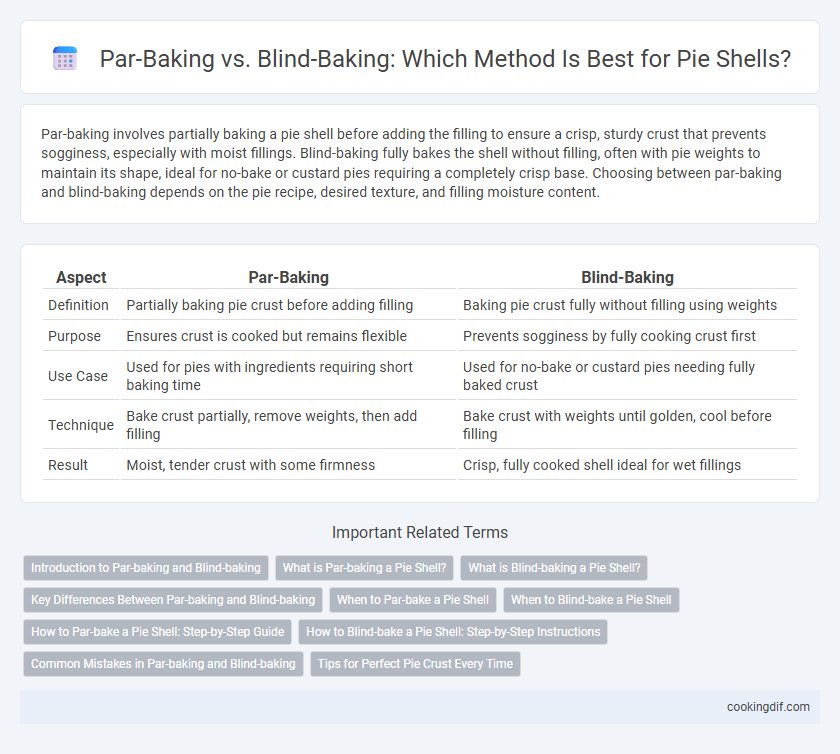Par-baking involves partially baking a pie shell before adding the filling to ensure a crisp, sturdy crust that prevents sogginess, especially with moist fillings. Blind-baking fully bakes the shell without filling, often with pie weights to maintain its shape, ideal for no-bake or custard pies requiring a completely crisp base. Choosing between par-baking and blind-baking depends on the pie recipe, desired texture, and filling moisture content.
Table of Comparison
| Aspect | Par-Baking | Blind-Baking |
|---|---|---|
| Definition | Partially baking pie crust before adding filling | Baking pie crust fully without filling using weights |
| Purpose | Ensures crust is cooked but remains flexible | Prevents sogginess by fully cooking crust first |
| Use Case | Used for pies with ingredients requiring short baking time | Used for no-bake or custard pies needing fully baked crust |
| Technique | Bake crust partially, remove weights, then add filling | Bake crust with weights until golden, cool before filling |
| Result | Moist, tender crust with some firmness | Crisp, fully cooked shell ideal for wet fillings |
Introduction to Par-baking and Blind-baking
Par-baking involves partially baking the pie shell before adding filling, ensuring it holds shape and prevents sogginess during final baking. Blind-baking requires baking the crust fully without filling, often with pie weights to avoid puffing, ideal for recipes with no-bake fillings. Both techniques improve texture and structural integrity of the pie shell for different types of pies.
What is Par-baking a Pie Shell?
Par-baking a pie shell involves partially baking the crust before adding the filling, ensuring the bottom stays crisp and prevents sogginess. This method typically requires baking the shell at 375degF (190degC) for 15-20 minutes until it is just set but not browned. Par-baking is ideal for fruit pies or custard pies where the filling requires less baking time than the crust.
What is Blind-baking a Pie Shell?
Blind-baking a pie shell involves pre-baking the crust without any filling to ensure a crisp, fully cooked base that prevents sogginess from moist fillings. This method typically uses pie weights or dried beans to keep the dough from puffing up or shrinking during baking. Blind-baking is essential for custard or cream pies, where the filling requires little or no baking time.
Key Differences Between Par-baking and Blind-baking
Par-baking partially cooks the pie shell to set its structure before adding a filling that requires further baking, ensuring a crisp crust without overcooking the filling. Blind-baking fully cooks the pie crust independently, often with pie weights to prevent puffing, ideal for fillings that do not need additional baking. The key difference lies in the degree of baking and timing relative to filling preparation, affecting texture and final moisture levels of the crust.
When to Par-bake a Pie Shell
Par-baking a pie shell is essential when the filling requires minimal baking time or is no-bake, such as custard or cream pies, to ensure the crust stays crisp and fully cooked. It is crucial to par-bake before adding wet fillings that could make the crust soggy during the finishing bake. Par-baking is recommended for pies with delicate fillings or when the filling and crust have significantly different baking times, optimizing texture and preventing a raw or soggy bottom.
When to Blind-bake a Pie Shell
Blind-baking a pie shell is essential when the filling is unbaked or has a shorter cooking time than the crust, such as custards, cream pies, or quiches. It prevents a soggy bottom by fully or partially pre-cooking the dough before adding wet fillings. Par-baking suits fruit pies where the filling and crust cook simultaneously, making blind-baking unnecessary.
How to Par-bake a Pie Shell: Step-by-Step Guide
To par-bake a pie shell, preheat the oven to 375degF (190degC) and line the dough with parchment paper before filling it with pie weights or dried beans to prevent bubbling. Bake the shell for 15-20 minutes until the edges turn golden but the center remains pale. Remove the weights and parchment, then bake an additional 5-7 minutes to set the crust without fully browning it.
How to Blind-bake a Pie Shell: Step-by-Step Instructions
Blind-baking a pie shell involves pre-baking the crust without filling to prevent sogginess and ensure a crisp texture. To blind-bake, first chill the pie dough in the refrigerator for at least 30 minutes, then line the crust with parchment paper or aluminum foil and fill it with pie weights or dried beans to maintain shape. Bake at 375degF (190degC) for 15 minutes, remove weights and lining, then bake for an additional 5-10 minutes until the crust turns golden brown and fully set.
Common Mistakes in Par-baking and Blind-baking
Common mistakes in par-baking pie shells include underbaking, which leads to a soggy crust, and neglecting to dock the dough, causing bubbles and uneven cooking. In blind-baking, failing to use pie weights or insufficiently lining the crust can result in shrinking or puffing up, compromising the shell's structure. Both methods require precise timing and temperature control to achieve a perfectly crisp and evenly baked pie shell.
Tips for Perfect Pie Crust Every Time
Par-baking pie shells involves partially baking the crust before adding filling, which prevents sogginess and ensures a flaky texture, ideal for custard or cream pies. Blind-baking uses pie weights or beans to keep the crust flat during baking, crucial for maintaining shape and avoiding puffing. For perfect pie crust every time, chill the dough thoroughly, dock the bottom to prevent bubbles, and use high-quality butter for rich flavor and crispness.
Par-baking vs Blind-baking for pie shell Infographic

 cookingdif.com
cookingdif.com